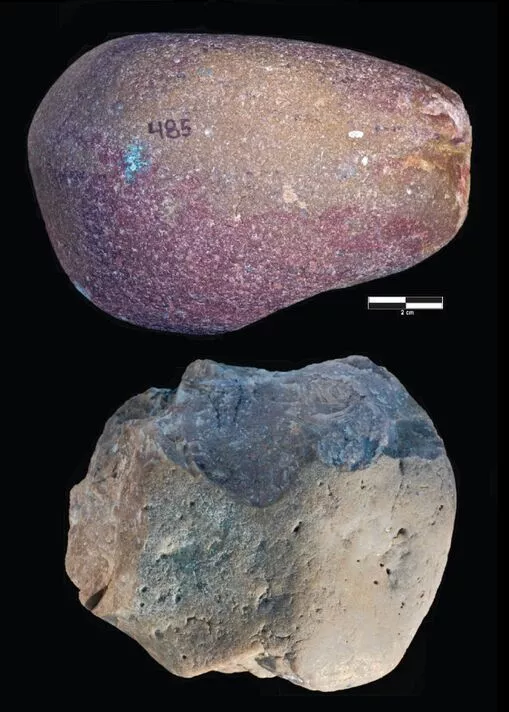Found near a 2.9 million-year-old Paranthropus’ 2 teeth
20% Off Custom Banners – Limited Time!
Recently, archaeologists discovered a site in East Africa. They uncovered several sophisticated stone tool artifacts that appear to be crafted with great skill and precision. The artifacts were prepared from various materials, including quartz, flint, and agate.
Along with the stone artifact, archaeologists discovered two intact teeth from an early hominin species known as the Paranthropus. This discovery is significant as it furthers our understanding of the lifestyle and culture of these early fossil hominin species and our common ancestors’ contribution to human evolution. [i]
It also provides insight into the development of stone tool technologies among early hominin populations. Further research and analysis of the artifacts and teeth could provide additional evidence and information about these ancient hominin species’ habits, behaviors, and evolution. [i] This newfound discovery has prompted researchers to ponder who the original creators of these tools were and how far back in time they were created. Some speculate that these tools indicate a more advanced civilization that predated the emergence of Homo Sapiens. Sahelanthropus tchadensis is, for example, one of the oldest known species of human origins. [i]
Thus, this leads to further questions about the duration and extent of this ancient civilization and what kind of technology they possessed. Furthermore, researchers are attempting to ascertain the implications this might have on the progression of humanity and the development of our own civilizations.[i] Others hypothesize that the tools were crafted by the Paranthropus species or even another unknown species of hominin. Whatever the case, this find is essential to understanding our ancient past. [i]

What did archaeologists recently unearth in Kenya?
The artifacts were newly unearthed and discovered along the shores of Kenya’s Lake Victoria. Researchers describe the artifacts as belonging to the Oldowan toolkit. [ii]
GOLD AND SILVER AVAILABLE! Shop now for a limited time only at SilverGoldBull.ca!
These sophisticated stone tools were used by early hominins inhabiting the Homa Peninsula. They used them to butcher hippos and antelope, pound vegetation, and perform various other tasks. [ii]
The tools discovered were used to construct additional devices and weapons, such as axes and spears. They also would use the tools to carve and shape objects. [ii]
The tools have been used for hundreds of thousands of years. They are a testament to the innovativeness and skill of the early hominins who were able to make stone tools. [ii]

The Oldowan industry, also known as Oldowan tools, marks the beginning of the technological revolution. Previously, these artifacts were believed to have appeared 2.6 million years ago in Eastern Africa. [iii] However, new discoveries have revealed that they can be dated even further – to 2.9 million years ago. They were used at an abandoned butchery site. [iii] These tools are composed of essential stones, like quartz, flint, and basalt, used by ancient hominins to cut, pound, and scrape different materials. The toolkit is characterized by its simplicity, as it was made without heating or hammering. The discovery of Oldowan tools provided evidence of the effectiveness of early humans in creating primitive technology and demonstrated the beginnings of the technological revolution. [iii]
Why are these stone tools so notable?
The Oldowan is a stone tool industry believed to be the earliest accepted by archaeologists. It is characterized by flaked tools such as scrapers, choppers, and rudimentary cutting tools. These tools gave our ancestors a tremendous evolutionary advantage during the Oldowan period. [iv] They allowed them to access food sources, build shelters, and defend themselves more efficiently. Furthermore, the development of these tools allowed for the emergence of more complex technologies and tools, enabling our ancestors to spread out of Africa and colonize the world. [iv]
Introducing more sophisticated tools increased access to various new food sources, such as plants, animals, and fish. Additionally, these tools allowed us to process raw materials like bone and wood, which could be used to create new tools and weapons. [v]
The Archeulean industry, notable for the distinctively oval and bifacial-shaped hand axes, would replace the Oldowan industry, characterized by simple stone tools. This new industry allowed humans to access a more comprehensive array of food sources, which provided more nutrition and allowed for population growth. [v]
NYC Visitor Centers page
It also vastly increased the efficiency of tool-making, allowing us to create more complex tools that could be used for various purposes.[v]
This new discovery pushed the recorded onset of Oldowan stone tools by nearly 300 thousand years. The devices were utilized almost 2 million years before hominins began harnessing firepower. [vi]
Toolmakers are believed to have pounded their meat into something similar to a hippo tartare to make it easier to consume. Researchers believe this is one of the oldest examples of technology. [vi]
An anthropologist Professor Thomas Plummer spoke of the discovery. He stated that this illustrates that the toolkit was distributed sooner than people realized. It was used to process animal and plant tissues. We are still determining its adaptive significance, but the assortment of uses suggests it was essential to these hominins. [vii]

